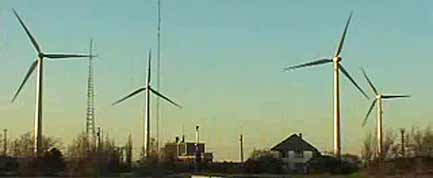
By 2030 the Department of Energy wants 20 percent of electricity produced in the United States to be generated by wind. Wind currently generates less than 1 percent of the country's electricity, so the increase will require the number of new wind turbine installations to jump from 2,000 to 7,000 per year, according to the DOE.
Although wind turbines, which typically stand 300 feet tall, are environmentally benign when compared to coal fired power plants, they are much more complex than the simple windmills of the past and face a number of operating problems that scientists are trying to solve. Several papers published recently in physics journals propose solutions to some of the current roadblocks in the path to reaching the 20 percent goal for wind power.
Some of the windiest locations in the nation also happen to be some of the coldest, and early experience with wind farms has revealed that turbine icing is one of the most significant threats facing the efficiency of the turbines.
In the Northern and Midwestern states where the wind blows hard and reliably, temperatures well below freezing are the norm during winter months and ice buildup on the long blades of the turbines can dramatically reduce their efficiency. Ice accumulation on the blades not only reduces the aerodynamic functions and efficiency of the turbine, but can throw the blades out of balance and force them to stop. Beyond the direct damage to the turbines, the blades shedding large piece of ice as they spin poses significant safety hazards to people and property.
Researchers Zheyan Jin and Hui Hu from Iowa State University, in Ames, have developed a method called molecular tagging thermometry to better understand the underlying physics of the ice buildup on turbine blades. The researchers are using their data to better predict where ice is most likely to build up. They hope they eventually can design turbine blades to take advantage of the natural heat exchange inside the blade, pushing heat toward the coldest areas to prevent ice from forming.
To reach the goal of 20 percent electricity generation by wind in a little more than 20 years, scientists and energy experts know that relying only on regions where the wind blows steadily and hard won't be enough.
Turbines that work efficiently in medium and low wind conditions must be developed and scientist Biplab Kumar Debnath and his colleagues at the National Institute of Technology in Assam, India, are working on plans and designs for wind turbines that can efficiently use these less intense wind resources.
Sign up for the Live Science daily newsletter now
Get the world’s most fascinating discoveries delivered straight to your inbox.
At the end of trials and tests, Debnath determined that the performance of a wind turbine that combines two distinct designs, each capable of operating in low-speed winds, into a single shaft would be more efficient. The objective was to combine the good features of both designs for optimal production, while reducing the impact of their separate weaknesses. Their goal is to increase the availability of wind energy worldwide.
Inside Science News Service is supported by the American Institute of Physics.









